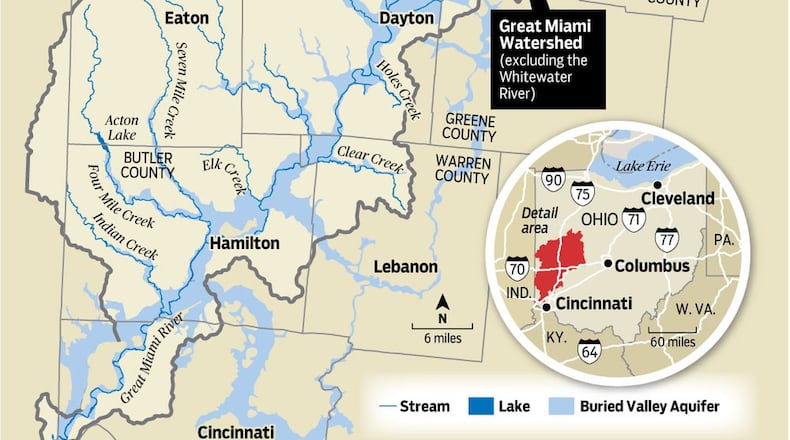The GMBVA is recognized as a Sole Source Aquifer by the United States Environmental Protection Agency (USEPA). This designation applies only to aquifers serving as the sole or principal source of drinking water for the local area and which, if contaminated, would create a significant hazard to public health. Due to its shallow depth (close proximity to the ground surface), and the presence of a relatively thin protective sediment cover, the Ohio EPA has found the GMBVA system to be under the influence of surface water by recharge that makes it susceptible to contamination.
In the last many decades, various industrial activities in the area have led to numerous accidents and spills that caused contamination to enter in certain parts of the underlying buried valley aquifer. Several former industrial facilities in the area have been classified as ‘Superfund Sites,’ which designated them as polluted locations as per federal guidelines, and the sites require a long-term response in order to clean up hazardous material in the aquifer.
USEPA is managing pollution cleanup at the following three Superfund sites in the Dayton and Riverside areas that are known as the Behr Dayton Thermal VOC plume, North Sanitary Landfill, also known as the Valley Crest Landfill, and Wright-Patterson Air Force Base. One more Superfund site has been added to the list recently, in 2016, known as Valley Pike VOC site. All of the above four sites are impacted by a group of chemicals collectively called ‘chlorinated solvents’ or ‘solvents’ for short, but also commonly known as Volatile Organic Compounds (VOCs) due to the ease with which they can evaporate and volatilize.
The specific VOCs found at the above sites are Trichloroethene (TCE) and Tetrachloroethene (PCE), and also their natural byproducts. TCE and PCE are legacy chemicals that were used in the U.S. in a variety of industrial applications for decades, but have been phased out. Since TCE and PCE do not breakdown easily in the environment, their contamination of the aquifer at the Superfund sites is mainly due to past spills as well as disposal practices. TCE and PCE are highly toxic and their level in the drinking water should not exceed above 5 micrograms per liter (or 5 parts per billion).
Coincidentally, the Behr Dayton Thermal VOC plume, North Sanitary Landfill, and Valley Pike VOC sites are all situated in close proximity to the two well fields from where drinking water is pumped out and then treated before supplying to the consumers. However, considerable scientific innovations now allow us to treat the contaminated zones of the aquifer directly and quickly by ‘bioremediation’ that employs native bacteria to convert the highly toxic TCE and PCE into benign byproducts cost effectively. A vigorous oversight is needed to destroy chlorinated solvents remaining areas of contaminated aquifer to protect drinking water quality.
The extensive aquifer contamination at the Valley Pike superfund site comes from decades of manufacturing activities that utilized TCE and PCE. The site was discovered in 2013, and then added to the Superfund program in 2016 due to the most serious and uncontrolled nature of the contamination at the site. The contaminated groundwater plume at the Valley Pike site begins at the manufacturing facility and flows to the southwest, which has affected hundreds of area residents due to entry of toxic vapors inside their homes.
Since September 2019, the Valley Pike site is going through an in-depth remedial investigation to better define the contamination and develop strategies for aquifer clean-up in order to protect the community health. The TCE and PCE liquid contamination at the site appears to have penetrated deep into the ground underneath affecting the aquifer. A dual approach will be needed to arrest further spread of toxic vapor as well as treatment of the contaminated groundwater plume in the short term to reduce the risk of human exposure. In addition, a strategy to destroy the VOCs in the source zone by injection of amendments into the subsurface may be appropriate.
Abinash Agrawal is a professor in the Department of Earth and Environmental Sciences at Wright State University
About the Author

